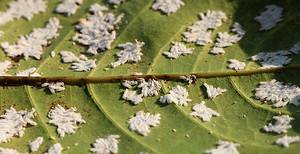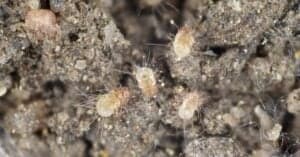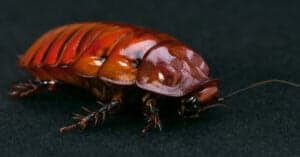When you think of a spider, you may think of something big and hairy, like a tarantula, or something small and poisonous, like a black widow. But what about the jumping spider? Jumping spiders are the biggest family (Salticidae) of spiders, with over 4,000 species worldwide and around 300 in the United States. Jumping spiders can be distinguished from other types of spiders by their eight eyes, often furry appearance, colorful markings, powerful front legs, and of course; their incredible jumping abilities.
With all of those unique characteristics, we are left with the question; just what do jumping spiders eat? Here, we’ll explore the jumping spider’s favorite foods, and how they hunt their prey. Then, we’ll compare what wild jumping spiders eat versus what pet jumping spiders eat. Finally, we’ll talk a little more about what baby jumping spiders eat, and how they get to adulthood.
Jumping Spider Diet
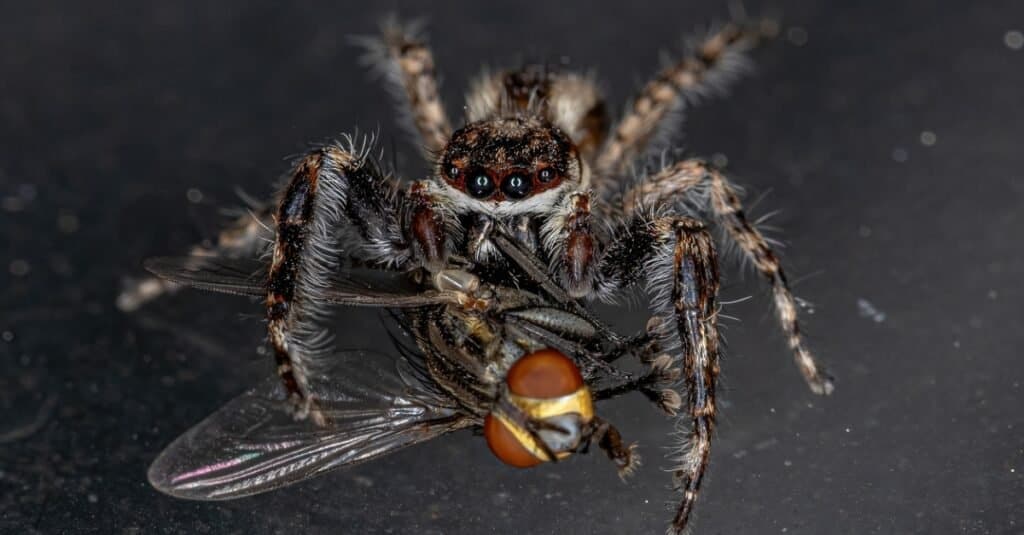
Jumping spiders eat flies,
wasps
, crickets, and more. They are mostly carnivorous.
©iStock.com/ViniSouza128
Jumping spiders eat insects like flies, moths, and crickets. They are predominantly carnivores, though they have been known to eat nectar.
In general, jumping spiders eat anything they can get their chelicerae (jaws) around. Flies, mealworms, moths, and other small, defenseless prey are their favorites. Jumping spiders will also eat crickets, cockroaches, and other spiders if given the chance. Their prey includes:
- Fruit flies
- Blue and green bottle flies
- Fly larvae
- Crickets
- Katydids
- Wasps
- Bees
- Butterflies
- Moths
- Other spiders
- Worms
- Mealworms
- Wax worms
Though jumping spiders are mostly carnivorous, they cannot be called obligate carnivores because they have frequently been observed drinking nectar. There is even one species of jumping spider, Bagheera kiplingi, that primarily eats plant material.
Jumping spiders have also occasionally been known to eat ants, though ants are far from their favorite prey. Ants, unlike most other insects that jumping spiders eat, have formidable defenses, making them a dangerous meal. There are some species of jumping spider that have specialized as ant-eaters though, and have hunting strategies specifically designed to keep them away from the ant’s strong jaws or spraying acid.
How Do Jumping Spiders Hunt?
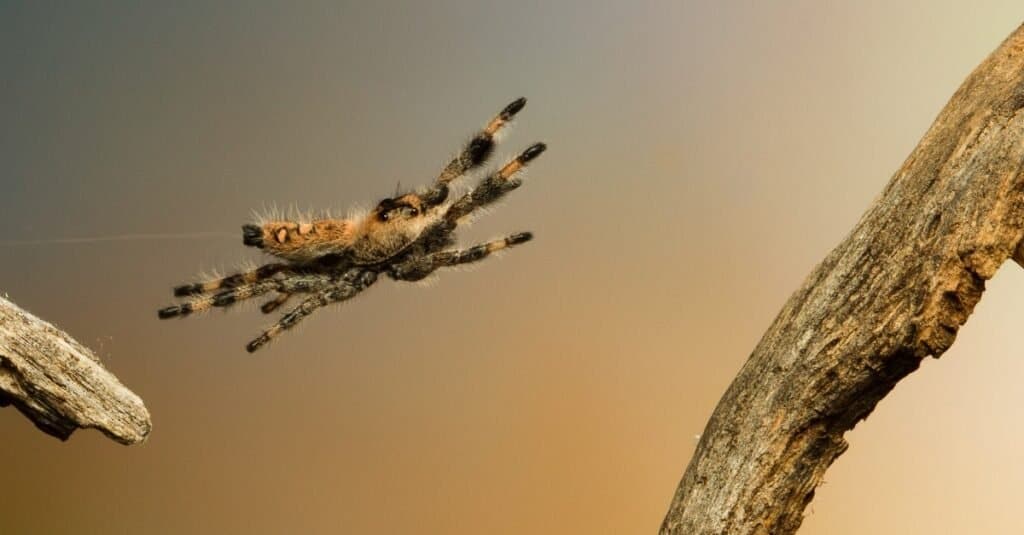
Jumping spiders hunt by leaping onto their prey from great distances
©iStock.com/memcockers
Jumping spiders, with their eight eyes and near 360-degree field of vision, have excellent eyesight. They use their great vision to spot prey like crickets or flies. Once they spot the unfortunate target, they spool out a string of silk and attach it to something solid. Next, using the silk as a safety line, the jumping spider leaps into the air, lands on its prey, and delivers a venomous bite that quickly incapacitates the victim.
Though jumping spiders tend to be small, less than one inch at the largest, they will attack prey many times their own size. Jumping spiders eat all kinds of insects, and have been known to kill crickets that dwarf them in size. To aid in their hunting, jumping spiders have large, powerful front legs that they use to hold the prey in place. Unlike other kinds of spiders, jumping spiders do not use webs to catch their prey. In fact, the only silk they spin is for their safety lines and the occasional cocoons they spin for molting, laying eggs, or wintering in.
What Do Wild Jumping Spiders Eat?
Wild jumping spiders eat almost any insect unfortunate enough to cross their path. Many species of jumping spiders are constantly on the move, constantly hunting. Some species sit and wait for prey to cross their path. But no matter what hunting method the jumping spider uses, they all eat roughly the same thing; insects. Wild jumping spiders eat flies, crickets, worms, and even other spiders. They are mostly carnivorous, though they do drink nectar, which officially classifies them as omnivores.
Jumping spiders, though formidable, are not dangerous to humans. They don’t generally bite unless in danger of being crushed. The jumping spider’s bite is extremely mild and often does not leave a mark. This makes them a popular spider for people who like to keep spiders as pets.
What to Feed Your Pet Jumping Spider
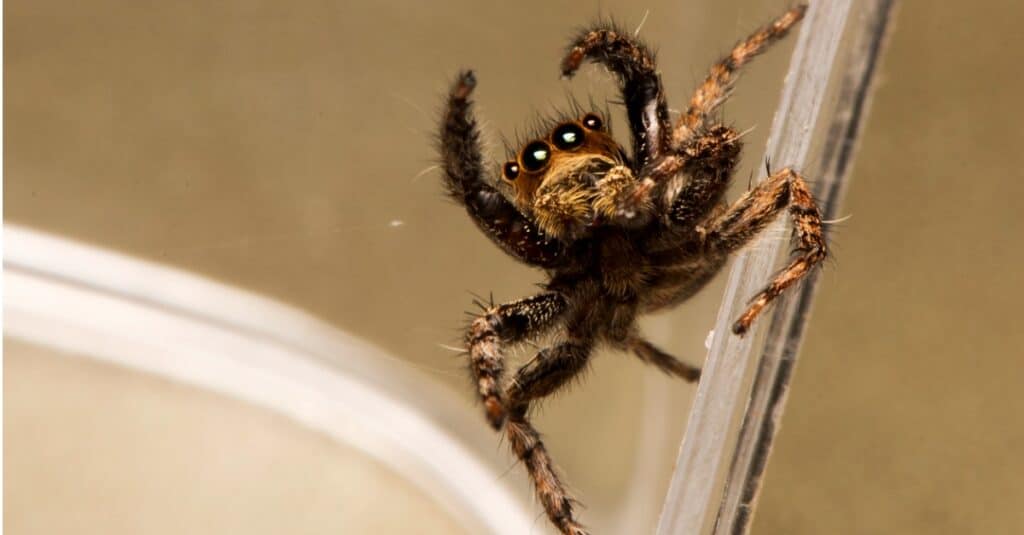
Captive jumping spiders can be fed flies, crickets, or mealworms
©iStock.com/19695866
Many people keep jumping spiders as pets. They can be purchased, but are more often caught outdoors in flower or vegetable gardens. Pet jumping spiders only need to be fed every three days or so, though it is not unusual for them to go a few weeks without eating. Captive jumping spiders eat crickets, flies, and mealworms mostly.
Jumping spider owners should be careful though, as some insects may actually harm their pet jumping spider. Crickets, if not immediately eaten, should be removed from the enclosure, as they can harm the jumping spider. This is particularly true if the jumping spider is older or close to molting. Similarly, owners should never try to feed ants to their jumping spiders. Ants can be dangerous, and may even kill the jumping spider, particularly if it is young.
What Do Baby Jumping Spiders Eat?
Baby jumping spiders eat more than adult jumping spiders. They prey on insects just like the adults, albeit smaller insects. Young jumping spiders drink nectar as well, making them omnivores, though they are mostly carnivorous. Small crickets, mealworms, and wax worms are the ideal prey for young jumping spiders.
Can You Keep a Wild Jumping Spider?
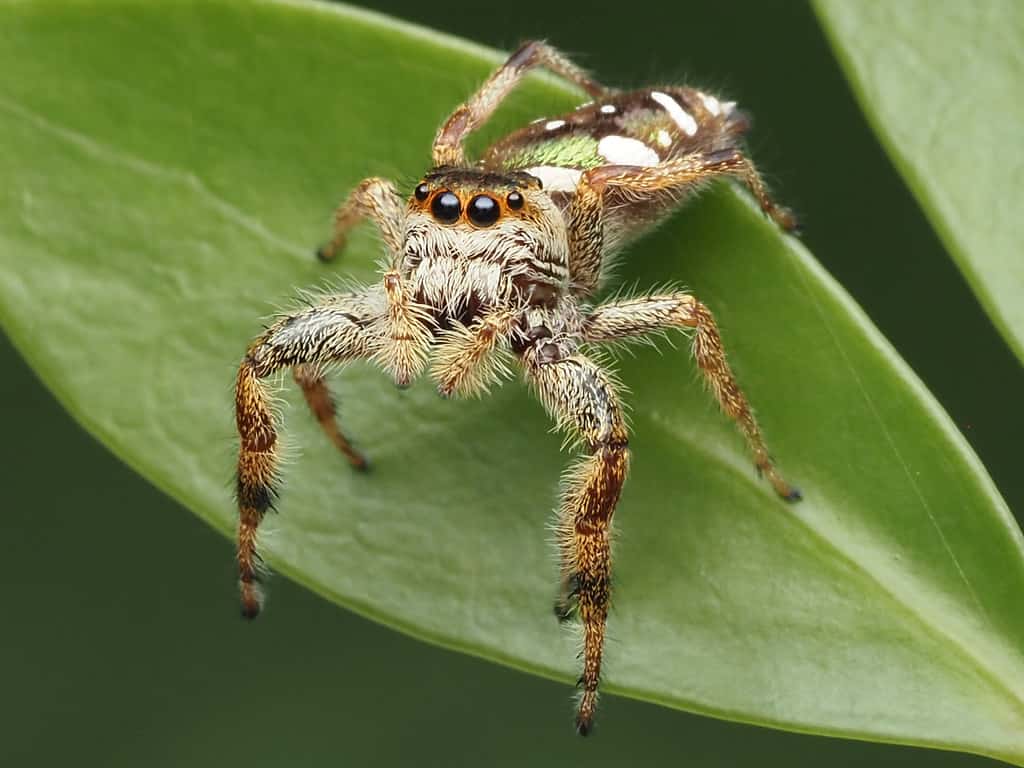
Emerald Jumping Spiders (
Paraphidippus aurantius) possess unique personalities and can make excellent pets.
©Zygy / CC0, via Wikimedia Commons – License
Jumping spiders are commonly found from Canada to the Atlantic coast states and stretches west to California. There are more than 5,800 described species found in the world, of which 300 are found in the United States. They have a wide range of habitats, from rocky areas, vegetation, wood piles, and even inside your home. These little jumpers are also known to frequent gardens, and as they make great pets, it is typically not advisable to take a wild spider, or wild animal of any kind, from its natural habitat.
There are some rare species of jumping spiders and often, people who take them from the wild are unaware of which type or what sex they have collected. Collecting a female is not generally the best choice as they may be carrying babies and you can create certain complications. Should you decide that you would like to have one for a pet, as they are low maintenance and easy to care for, you can find pet stores or breeders who will know which species you are receiving.
The photo featured at the top of this post is © iStock.com/19695866
Thank you for reading! Have some feedback for us? Contact the AZ Animals editorial team.



